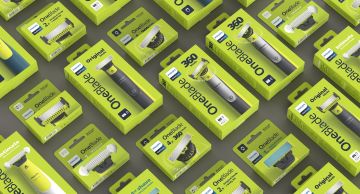
‘Design is always central within Philips’
Over the years, Philips Design has evolved from a standalone central function to a more integral presence across the business. In his earlier role as a Design Business Partner, Beaujean focused on connecting central design to business needs. Now, working directly within the Grooming & Beauty Business team, he sees how embedding design into the day-to-day is changing both the role of designers and the impact they can make across customer-, consumer- and user experience journeys. This closer alignment has strengthened design’s influence—bringing it closer to where decisions are made and enabling teams to shape experiences with greater relevance and speed.
"Design starts by asking the right questions—what problem are we solving, and for whom? Embedding design across the business helps us stay grounded in the needs of the people who use our innovations. That focus enables us to craft a more integrated product experience and drive more meaningful impact."
Enabling designers to better understand what the business needs are and how to respond to them is essential. Next to that it is vital to remain connected with design teams in other business units and central functions to ensure Philips continues to manifest itself as one brand with one connected experience. With this, Beaujean refers to Peter Skillman, Global Head of Design leading the central design function, as an anchor to help enable this.
‘Passion is the driving force behind good design’
Working as a designer within a large organisation like Philips requires several essential skills, according to Beaujean. Next to creativity, the ability to engage, inspire and communicate ideas is a key competence to drive impact, he emphasises. ‘A genuine belief in a vision and the passion to bring this vision to life is paramount.’
“Designers must be able to communicate their ideas effectively and inspire others. This requires not only creativity, but also a deep understanding of the business context in which they operate.”
‘Seamless and fit-for-future experiences’
Talking about his vision in Design, Beaujean refers to end-to-end experience development. With this he states that true impact can only be made if the design approach is fully business integral and transcends the focus on one touchpoint alone. ‘Delivering the most seamless experience in physical, digital and communication is the key objective of the team’ he states. ‘Ensuring we do this in the most fit-for-future way to ensure relevance for Philips is the fundamental goal’.
“What triggers me as a designer is the impact you can make. It's great to see our end-to-end work improve the lives of many people. That gives me immense satisfaction.”
‘Sustainability is an imperative’
In the context of fit-for-future experiences, sustainability is not an afterthought—it’s a starting point. Beaujean emphasizes that it’s a design imperative at Philips, built into their innovation approach through the company’s EcoDesign principles. That means looking beyond individual products to the full lifecycle: how solutions are designed, made, used, maintained, taken back, refurbished, and eventually recycled.
This mindset is especially visible in Philips’ growing refurb portfolio in the Netherlands, where designing for circularity has reshaped product development, experience design, and logistics. The aim isn’t just to make products more eco-friendly—it’s to show that refurbished can be just as desirable and reliable as new.
It also extends to packaging. With the paper-based system for the company’s popular grooming brand, OneBlade, Philips is reducing materials, parts and volume while also offering a step-up in the unboxing experience. As part of a broader platforming effort, this packaging approach is being scaled across categories and price points, reinforcing sustainability as a shared responsibility across the full value chain.
For Beaujean and his team, these are not standalone efforts. They reflect Philips’ broader ambition to embed sustainability into design decisions — and to keep evolving what that looks like in practice.
“Sustainability is a fundamental part of our business strategy, it is something we are committed to as a team.”
When asked about the role of events such as Dutch Design Week (DDW) in his practice, he points out that these events act as a platform for inspiration and collaboration. ‘DDW is a great opportunity to pick up signals and see or confirm that we are on the right track,’ he says. ‘Next to that it gives us a chance to connect with designers and design enthusiasts to exchange new ideas and start collaborations.’ Something of great importance in context of the dynamic times, challenges and opportunities we face.
The future of design within large organisations
With the recent changes, Philips is well-positioned to deliver a strong, connected brand experience to customers, consumers and users. Beaujean’s enthusiasm for his work and the impact of design is clear, it sets an inspiring example for the future of design within large organizations.
‘I look forward to further drive innovation and business relevance through design,’ says Beaujean. ‘Our approach shows there’s always a way to make life better and the possibilities are endless.’

Benito Walker
Benito Walker was involved in founding youth movement Youth for Climate NL in 2020, where he became its president. He later became a member of the youth platform of the Social and Economic Council (SER), chairman of Bureau Burgerberaad and vice-chairman of the National Youth Council, among others. Since 2023, he has been part of the jury of the Trouw Duurzame 100 (Sustainable 100), which he now chairs. Walker studies public administration at Leiden University and lives in The Hague.

